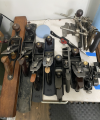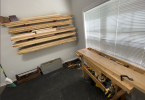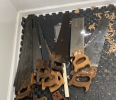Hi everyone, I'm new to NCWW and relatively new to woodworking, although I grew up helping my Dad and as a mechanical engineer I'm not totally ignorant of making things. I've basically gone from zero to all the hand tools in the world over the last few months, trying my best to get everything I need to be successful. For context, I live in an apartment and have turned my spare room into sort of a woodworking shop. I have a table saw, but can only use it outside since it's way too loud to use indoors, so I'd only use it on my back patio.
I recently got a great deal on about 120 bd ft of 6/4 lumber that is 9.5" x 80". It was a great price (about $5/bd ft) but now i have this huge pile of rough lumber and only hand tools to flatten it with. I got about a quarter of one done and it took absolutely forever!
So my question is, what is the best strategy to dimension all of this lumber? I am a big proponent of "work smarter, not harder," but given the task and the tools involved, I think I'm going to have to work VERY smart and VERY hard to have any chance of getting all this wood into S4S lumber.
Any tips to make my life a little easier over the next few weeks?
As far as relevant tools at my disposal, I have the following: a decent (but small) workbench with dog holes and a vise; Stanley planes no. 4 smoothing, no. 5(x2) jack, Bedrock no. 607 jointer, no. 40 scrub, no. 60 1/2 block plane, no. 78 rabbet, and no. 45 combination; and a wide assortment of hand saws. I've attached some pictures to give a better idea of the task and tools at hand.
How should I go about this? Where do I start? Do I do all the steps on each piece individually or should I do each step on every board before moving to the next step? Is this even worth it, or should I just go buy some S4S lumber instead? It's all very overwhelming.
Edit: The rough lumber is mostly white oak (85%) with a bit of yellow pine (15%). I'm located in northern Cary near N Harrison Ave. and NW Maynard Rd.
I recently got a great deal on about 120 bd ft of 6/4 lumber that is 9.5" x 80". It was a great price (about $5/bd ft) but now i have this huge pile of rough lumber and only hand tools to flatten it with. I got about a quarter of one done and it took absolutely forever!
So my question is, what is the best strategy to dimension all of this lumber? I am a big proponent of "work smarter, not harder," but given the task and the tools involved, I think I'm going to have to work VERY smart and VERY hard to have any chance of getting all this wood into S4S lumber.
Any tips to make my life a little easier over the next few weeks?
As far as relevant tools at my disposal, I have the following: a decent (but small) workbench with dog holes and a vise; Stanley planes no. 4 smoothing, no. 5(x2) jack, Bedrock no. 607 jointer, no. 40 scrub, no. 60 1/2 block plane, no. 78 rabbet, and no. 45 combination; and a wide assortment of hand saws. I've attached some pictures to give a better idea of the task and tools at hand.
How should I go about this? Where do I start? Do I do all the steps on each piece individually or should I do each step on every board before moving to the next step? Is this even worth it, or should I just go buy some S4S lumber instead? It's all very overwhelming.
Edit: The rough lumber is mostly white oak (85%) with a bit of yellow pine (15%). I'm located in northern Cary near N Harrison Ave. and NW Maynard Rd.
Attachments
Last edited:



